|

|
Greatest Space Events of the 20th Century
In this series of five articles, space.com takes a decade-by-decade look at the 20th century's most significant developments in space.
By Andrew Chaikin, Executive Editor, Space and Science,
and Anatoly Zak
Eric Hartwell
contributed additional pictures and captions,
collated, and reformatted these articles.
|
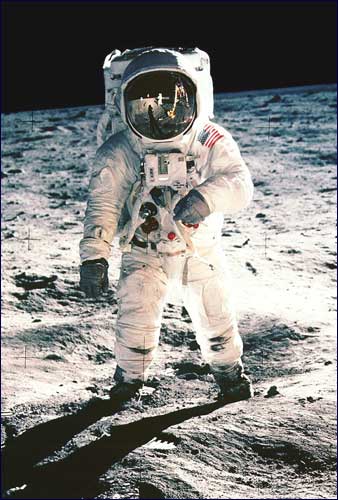 |
|
Greatest Space Events of the 20th Century: The Fifties
By Andrew Chaikin,
space.com Executive Editor, Space and Science
posted: 11:33 am EST 27 December, 1999
 When you think of the 1950s, you might recall the decade's contributions to popular
culture: Rock n' Roll, hula hoops, and horror films featuring a menagerie of giant
radioactive beasts. Long after Godzilla is forgotten, however, the fifties will be
remembered as the dawn of the space age.
When you think of the 1950s, you might recall the decade's contributions to popular
culture: Rock n' Roll, hula hoops, and horror films featuring a menagerie of giant
radioactive beasts. Long after Godzilla is forgotten, however, the fifties will be
remembered as the dawn of the space age.
For space exploration, the fifties were a time when fantasy changed to reality. At the
start of the decade, space travel was something that existed only in the pages of science
fiction, the kind of thing most people didn't talk about in serious tones. By its end, a
newly-created U.S. space agency was selecting pilots for real space voyages.
|
|


Von Braun's three-stage manned rocket with winged
glider for landing, and 250-foot-diameter space station.

Spacecraft for the moon landing (unstreamlined
to operate solely in the vacuum of space),
to be assembled in orbit nearby
|
A Cold War Quest
At first glance, it might seem that inspiration -- a love of exploration, a
fascination with the unknown -- was at the heart of this dramatic change. And it is
true that the fifties were ripe with inspiring writings about worlds beyond. A series
of articles in Colliers magazine, beginning in 1952, offered fantastic visions
of humanity's future in space, written by experts in the field and illustrated with
stunning works by such artists as Chesley Bonestell and Fred Freeman. The opening
installment in the Colliers series declared, "Man Will Conquer Space Soon."
Such presentations served to raise the American public's awareness that such things
were going to happen -- but would they happen as quickly as Colliers promised?
In 1952, no one would have guessed that only five years remained before the first Earth
satellite would be launched, and only seven before the nation's first astronauts would
be named. The reason those developments came as soon as they did -- and the force behind
the fifties' push into space -- was the Cold War.
The years after World War 2 were marked by growing tensions between the United States
and the Soviet Union. Soon after the war ended, both sides engineers who knew how to build
large, liquid-fueled rockets. And the U.S. monopoly on nuclear weapons ended in 1949, when
the Soviets tested their first atomic bomb. By the early 1950s, the U.S. and
U.S.S.R. were working to merge these technologies in a terrible new weapon, the
Intercontinental Ballistic Missile (ICBM).
|
|

R-7 - Credit: © Mark Wade.
|
Until very recently, most historians believed the Soviets got there first.
A brilliant engineer named Sergei Korolev led the Soviet ICBM effort, and his team
created a powerful new booster, officially designated R-7, but known to Korolev's team
by its Russian nickname Semyorka ("number seven"). It stood almost 100 feet high
and developed 880,000 pounds of thrust at liftoff. In August 1957, Semyorka flew
to its full range of almost 4,000 miles (2480 kilometers) -- enough to qualify it as an
intercontinental rocket. But the dummy warhead at the rocket's nose was destroyed during
reentry into the Earth's atmosphere. The Soviets made no mention of mishap in their
public statements. However, such problems would continue to plague the Russian ICBM
effort until December 1959, when the R-7 was declared an operational weapon. The
Americans, meanwhile, made a successful test of their own ICBM, called Atlas, in late 1958.
The Space Race Begins
The ICBM was only part of Korolev's efforts. Korolev had bigger dreams: He wanted to
explore space. Under Korolev's direction, Semyorka was became the world's first
satellite launcher. On October 4, 1957, it sent the first satellite, Sputnik, into orbit.
|
|
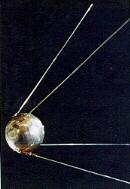
Sputnik 1
|
Sputnik's bleeping electronic cry, heard by amateur radio operators around the world,
announced that the Soviets had scored not only a scientific achievement, but a strategic
one. If they could put a satellite in orbit -- and especially the 1,121-pound
(2,466-kilogram) Sptunik 2, which carried the first space passenger, a dog, in November
1957 -- then they could loft a nuclear warhead into orbit, where it could threaten any
American city. This was already clear after the R-7's test launch in August, but it was
only after Sputnik that the American public took the threat seriously.
|
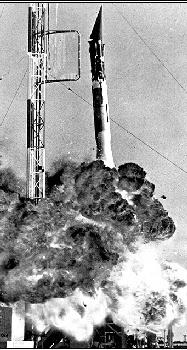
The explosion of Vanguard in
America's first launch attempt
|
|
Spurred in part by the public and media reactions to Sputnik, which bordered on
hysteria, U.S. President Dwight Eisenhower stepped up plans for the first U.S.
satellite, which had been scheduled for launch as part of the 1958 International
Geophysical Year. The first attempt, using a booster called Vanguard, ended in
failure on December 6, 1957; the rocket rose only a few feet, then sank back to Earth
and exploded.
|
|
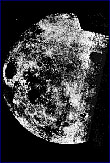
The far side of the moon,
as photographed by the
Soviet Luna 3 probe in
October, 1959. |
Now hope rested with the U.S. Army's rocket team, headed by Wernher von Braun, who
had led the development of the V-2 missile in Nazi Germany. Von Braun's rocket, called
Jupiter C, successfully launched Explorer 1 on January 31, 1958. The U.S. had joined
the "space race."
But the Soviets held the lead. In January 1959, after several launch failures, they
fired a small probe, called Luna 1, past the moon, missing it by about 3,100 miles
(5,000 kilometers). Then, just past midnight, Moscow time, on September 14, the Soviets'
Luna 2 struck the lunar surface, becoming the first artificial object to reach another
celestial body. And in early October, Luna 3 swung around the moon and sent back the
first pictures of its hidden face.
The Americans, meanwhile, suffered a series of embarrassing failures with their
Pioneer spacecraft, which were designed to explore the moon's environment. Most failed
to escape Earth orbit; more than one blew up before reaching space. Pioneer 4, launched
in March 1959, was able to achieve lunar distance, missing the moon by 37,500 miles
(60,500 kilometers).
|
|
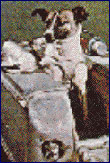
The dog Laika was launched
aboard Sputnik 2 to become
history's first space passenger.
|
Bigger Things Ahead
Even as the two superpowers lobbed robotic spacecraft at the moon, the space race
was becoming an even higher-stakes game. In April 1959 seven pilots were selected by
the newly created National Aeronautics and Space Administration as astronauts for
Project Mercury, the U.S. effort to put a man in orbit.
The Soviets, meanwhile, were training their own crop of space fliers, called
cosmonauts, who also hoped to be the first into space.
In the coming decade, astronauts and cosmonauts would set their sights on historic
journeys in space -- not only into Earth orbit, but to the moon.
Anatoly Zak and Eric Hartwell contributed to this article.
Timetable of Space Events: 1950s
|
Missions |
|
Achievement |
Country |
Spacecraft |
Launch Date |
|
First successful test of ICBM |
Soviet Union |
R-7 rocket |
August 21, 1957 |
|
First Earth satellite |
Soviet Union |
Sputnik |
October 4, 1957 |
|
First animal in space (the dog
Laika) |
Soviet Union |
Sputnik 2 |
November 3, 1957 |
|
First U.S. Satellite |
United States |
Explorer 1 |
January 31, 1958 |
|
First spacecraft to reach lunar distance |
Soviet Union |
Luna 1 |
January 2, 1959 |
|
First spacecraft to strike moon |
Soviet Union |
Luna 2 |
September 12, 1959 |
|
First photographs of lunar far side |
Soviet Union |
Luna 3 |
October 4, 1959 |
http://www.space.com/spacehistory/greatest_space_events_1950s.html
Copyright ©1999 space.com, inc. ALL RIGHTS RESERVED.
Greatest Space Events of the 20th Century: The Sixties
By Andrew Chaikin,
space.com Executive Editor, Space and Science
posted: 05:05 pm EST 27 December 1999
|
|
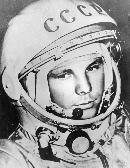
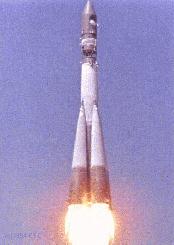
The Vostok 1 launch of the first
man in space,Yuri Gagarin
|
For America, the 1960s begin on an anxious note. Many in the U.S. feared the
nation was lagging dangerously behind the Soviet Union in development of
Intercontinental Ballistic Missiles (ICBMs). In reality, secret photos from
American spy satellites were about to confirm what high-flying aircraft had
already shown: the so-called missile gap was not real.
But the Eisenhower administration could not reveal this knowledge to the
public, and in 1960 John Kennedy won the presidency over Eisenhower's Vice
President, Richard Nixon, partly on the strength of his stance on the missile
gap.
When it came to space exploration, no one could be sure how much Kennedy
would improve on his predecessor's lukewarm attitude. Within months after
entering office, however, Kennedy had no choice but to focus on human
spaceflight.
On April 12, 1961, the Soviets launched a 27-year-old fighter pilot named
Yuri Gagarin on the world's first piloted space mission. In his spacecraft
Vostok ("east"), launched atop a converted R-7 missile, Gagarin made
a single orbit of the Earth, returning 108 minutes after liftoff.
The Soviets did not reveal that the Vostok had suffered a malfunction prior
to reentry that almost killed Gagarin. When the cosmonaut returned unharmed and
exhilarated by his flight, the Soviet Union had scored another key space
victory.
Kennedy Reacts
For the young American president, Gagarin's flight came as a serious blow.
In Kennedy's mind, competition with the Soviets in space had become vital to
U.S. international prestige. On May 5, a former Navy test-pilot named Alan
Shepard -- judged by many to be the best pilot among the Original Seven
astronauts -- became the first American in space.
|
|

Alan Shepard inside his Mercury capsule, ready for launch.
|
Inside his tiny Mercury spacecraft, which he named Freedom 7, Shepard
rode a Redstone booster on a 15-minute suborbital flight. The nation reacted to
Shepard's feat with wild enthusiasm, and Kennedy took notice.
Kennedy had already been thinking about how to pull ahead of the Soviets in
space. He'd asked his advisors to come up with a project that would give the
U.S. a clear victory.
Less than three weeks after Shepard's flight, speaking before a joint
session of Congress, Kennedy made an announcement that would have seemed
unthinkable just years before: "I believe this nation should commit itself
to achieving the goal, before this decade is out, of landing a man on the moon
and returning him safely to the Earth."
Many who heard these words -- including some at NASA -- wondered if
Kennedy's challenge was realistic. (A few even wondered if Kennedy had lost his
senses.) But it didn't take long for the space agency to begin figuring out how
to achieve it.
Meanwhile, the space race sped onward with ever more ambitious flights.
John Glenn -- the astronaut who seemed to step most easily into the role of
American hero -- became the first American to orbit the Earth on February 12,
1962. Inside his Friendship 7 spacecraft Glenn circled the globe three
times, marveling at the beauty of orbital sunrises and sunsets before sweating
through a fiery reentry into the Earth's atmosphere.
Three more astronauts followed Glenn into orbit; in May 1963 the sixth and
last piloted Mercury mission saw Gordon Cooper spending more than a day in
space.
|
|
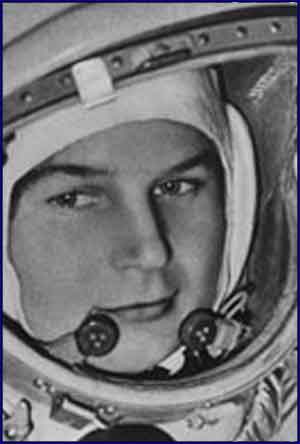
Valentina Tereshkova, first
woman in space, in 1963.
|
As important as these missions were for the U.S. program, they were
overshadowed by the Soviet Vostok flights. Cosmonaut Gherman Titov made the
first day-long flight in 1962. Andriyan Nikolayev in Vostok 3 and Pavel
Popovich in Vostok 4 staged the first dual space flight in 1963. Also in 1963,
a former cotton mill worker and parachute jumper named Valentina Tereskhkova
became the first woman in space, logging almost 3 days in Vostok 6.
And the Soviet firsts didn't end there. Under pressure from Soviet premier
Nikita Kruschchev, chief space designer Sergei Korolev staged another orbital
"spectacular." The Americans were planning their two-man Gemini
flights, but Korolev upstaged Gemini's planned debut by launching three
cosmonauts in a "new" spacecraft called Voskhod ("sunrise").
In reality, Voskhod 1 was nothing more than a converted Vostok. Only by
taking the dangerous step of denying the cosmonauts ejection seats and space
suits was Korolev able to achieve the feat. Fortunately, Voskhod 1 flew without
mishap.
But that wasn't true for the Voskhod 2 team of Pavel Belyayev and Alexei
Leonov, who made their day-long mission in March, 1965.
Early in the flight, a space-suited Leonov wriggled into a narrow,
inflatable airlock attached to the Voskhod's cabin, leaving Belyayev to pilot
the ship. Leonov then emerged into the void and spent several minutes floating
free, in history's first space walk.
|
|
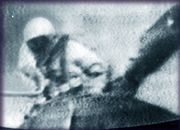 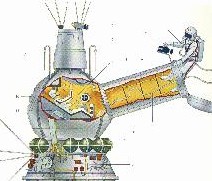
When Leonov returned from his historic 1965 spacewalk, he found
he couldn't fit back in the hatch. (AP File Photo). No good quality
pictures are available because the outside camera could not be
retrieved from the airlock, which was ejected before re-entry.
|
Leonov almost didn't live to tell the tale: In the vacuum of space his suit
ballooned dangerously, making it almost impossible for him to get back inside.
Only by releasing some of his suit's air -- an almost desperate measure,
considering the risk of decompression sickness -- was the exhausted cosmonaut
able to re-enter the cabin.
Once again, the world was not told of these difficulties, and Leonov's feat
seemed to leave the U.S. program in the dust. But it would not be long before
the Americans caught up.
A Bridge to the Moon
Even as the Soviets racked up one space first after another, NASA was
getting closer to the first piloted Gemini missions. Launched by a converted
Titan 2 missile, Gemini was the most sophisticated spacecraft yet created.
Gemini astronauts would utilize an onboard computer. And they would be able to
change their orbit -- something no Soviet crew had yet accomplished.
For NASA, Gemini would serve as a bridge between the relatively simple
Mercury flights and the awesome challenge of the Apollo moon program.
In just 20 short months between March 1965 and November 1966, 10 Gemini
crews pioneered the techniques necessary for a lunar mission.
|
|
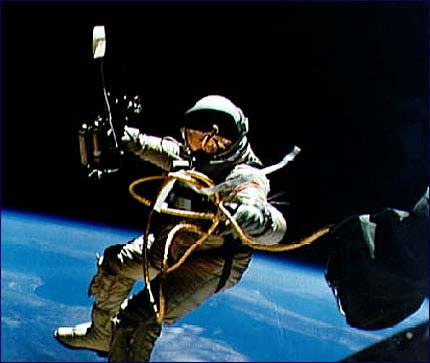
Floating outside Gemini 4, Ed White holds
a nitrogen-powered maneuvering gun.
|
They made space walks, some lasting more than two hours. They spent a
record-breaking 14 days in space -- the expected duration of a lunar landing
flight -- in a cabin no bigger than the front seat of a Volkswagen. (One
astronaut later called the two-week Gemini 7 flight "the most heroic
mission of all time.")
They mastered the arcane complexities of orbital mechanics to achieve the
first rendezvous between two spacecraft in orbit, and the first space docking.
And they made the first controlled reentries into the Earth's atmosphere.
To be sure, the Gemini missions had their harrowing moments, none more so
than when Gemini 8 astronauts Neil Armstrong and Dave Scott barely escaped
disaster when one of their maneuvering thrusters malfunctioned, causing their
spacecraft to tumble wildly through space.
And several spacewalkers had their own difficulties -- working in
weightlessness was trickier than NASA expected, and more than one sortie had to
be cut short when an astronaut became exhausted. Despite these problems, Gemini
was considered a tremendous success. It gave the United States the lead in the
space race, which was about to become a moon race.
Robotic Explorers
|
|
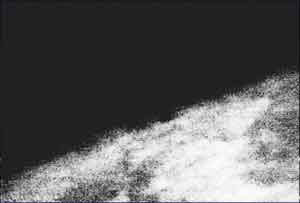
Mariner 4's first closeup image of Mars in 1965.
|
Meanwhile, the Americans and Soviets were extending humanity's reach beyond
Earth orbit by means of ever more sophisticated robotic probes. The U.S.
Mariner 2 became the first interplanetary spacecraft when it flew past Venus in
1962 and sent back data about this cloud-hidden world. Another American craft,
Mariner 4, took the first closeup pictures of Mars in 1965.
Closer to home, in 1966, the Soviet Union achieved the first soft landing of
a spacecraft on another world, when Luna 9 came to rest on the moon's Ocean of
Storms and sent back images of its dusty surface.
Also in 1966, U.S. Surveyor landers began exploring the lunar surface, and a
series of Lunar Orbiter spacecraft began a detailed photo-reconnaissance of the
moon from orbit. These missions not only advanced scientific understanding of
Earth's nearest neighbor; they helped pave the way for the piloted missions
that would follow.
Disaster and Triumph
By 1967, both the United States and the Soviet Union were ready to test the
spacecraft they would use to send humans to the moon. In the process, both
countries suffered devastating failures.
On January 27, 1967, the crew of the first piloted Apollo mission --
veterans Gus Grissom and Ed White, and rookie Roger Chaffee -- perished when a
flash fire swept through the sealed cabin of their Apollo 1 command module.
NASA's investigation of the tragedy revealed numerous technical flaws in the
craft's design, including the need for a quick-opening hatch, and fireproof
materials in the cabin. The fire would ultimately delay the Apollo program for
more than 20 months.
Disaster struck the Soviets in April 1967, when cosmonaut Vladimir Komarov
piloted Soyuz 1 ("union"), an Earth-orbit precursor of a planned
lunar-orbit vehicle. When Komarov's flight was plagued by malfunctions,
controllers ordered him to come home early. But the craft's parachute did not
deploy properly, and Soyuz 1 slammed into the Earth at tremendous speed,
killing Komarov. The Soviets too had found that winning the moon race could
exact a terrible price.
|
|
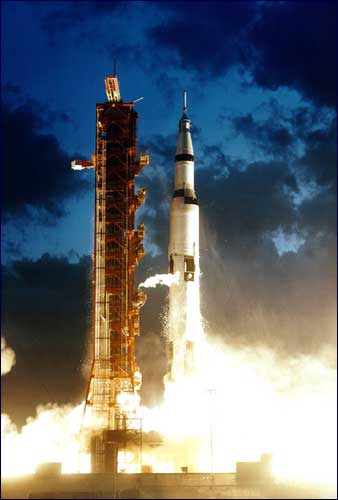
Apollo 4 liftoff.
|
For the Americans, at least, 1967 ended on a triumphant note with the debut
of the giant Saturn 5 moon rocket. Towering 363 feet above its launch pad, the
Saturn's three stages contained as much chemical energy as an atomic bomb.
When it lifted off on November 9, with 7.5 million pounds of thrust, the
Saturn's fire and thunder were truly awesome to behold. For NASA, the Saturn
5's flawless test flight marked a key milestone on the road to the moon.
Apollo rising
Americans returned to space on October 11, 1968, when the crew of Apollo 7
made an 11-day Earth-orbit test of the Apollo command and service modules,
which had been redesigned in the wake of the fire.
The flight went so well -- one mission controller dubbed it "101
percent successful" -- that NASA decided to take a stunningly bold step
with Apollo 8: its crew would orbit the moon.
There was a note of urgency in the plan: Intelligence reports showed that
the Soviets, who had recovered from the loss of Soyuz 1, were planning to send
two cosmonauts on a circumlunar flight before the end of the year.
But after two unpiloted circumlunar test flights experienced malfunctions in
the fall of 1968, Soviet officials refused to give the go-ahead for a piloted
mission.
|
|
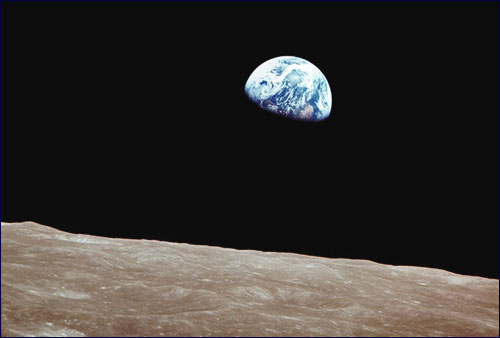
Apollo 8 Earthrise.
|
The way was clear for the Apollo 8 crew -- Frank Borman, Jim Lovell, and
Bill Anders, to make history.
On December 24, 1968, after a 66-hour journey across 230,000 miles of space,
the three men fired their spacecraft's main engine to go into lunar orbit. They
remained there for 20 hours, making navigation sightings, taking photographs
and beaming live television pictures back to Earth, before returning home.
After a reentry at 25,000 miles per hour -- faster than humans had ever
traveled -- Borman's crew splashed down safely in the waters of the Pacific.
Apollo 8 was more than a technical triumph, more even than a milestone in
exploration: It was a mountaintop experience for the entire human species. A
single photograph from Apollo 8, showing the Earth rising beyond the moon's
barren horizon, became one of the century's most famous and inspiring images.
For the Soviets, Apollo 8's success was a stinging defeat that seemed to
take the wind out of their own moon effort, at least temporarily. For NASA, it
had the opposite effect. Now the way was clear to attempt the lunar landing. If
all went well on Apollos 9 and 10, Apollo 11 would try for a landing the next
summer. But that was a big "if"; each mission ranked as one of the
most complex and difficult space missions ever attempted.
|
|
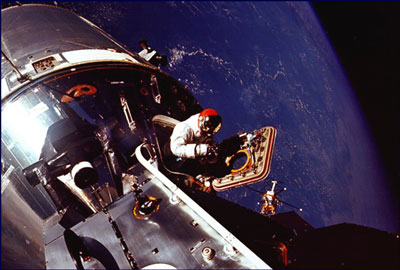
Apollo 9 space walk
|
Amazingly, both Apollo 9 -- an Earth-orbit test of the entire Apollo
spacecraft -- and Apollo 10 -- a "dress rehearsal" for the landing in
lunar orbit -- were almost flawless.
When Apollo 10 splashed down on May 26, Neil Armstrong and his Apollo 11
crew had less than two months left to prepare for the ultimate test flight.
To Land on the Moon
July 16, 1969 dawned clear and hot for the spectators (estimated at a
million people) who flocked to Cape Kennedy for the Apollo 11 launch.
They were not disappointed.
At 9:32 a.m., the Saturn 5 came to life, its fire akin to a second sun, its
roar shattering the morning stillness as it sent Armstrong and crewmates Buzz
Aldrin and Mike Collins on history's third lunar voyage. Three days later the
men arrived in lunar orbit, knowing that their real mission -- the landing
attempt -- was about to begin.
On July 20, Armstrong and Aldrin, clad in their space suits, took their
places in the tiny cabin of the Lunar Module Eagle, leaving Collins to
pilot the command ship Columbia. The two ships separated, and with a
blast from their lander's descent engine, Armstrong and Aldrin began their trip
down to the moon's Sea of Tranquillity.
At 50,000 feet they ignited Eagle's engine once more, beginning the
landing's final phase, called the Powered Descent. Everyone knew there could be
problems, and there were: On the way down, an overloaded computer threatened to
abort the mission; only quick thinking by experts in mission control allowed
Armstrong and Aldrin to continue.
A thousand feet above the moon, Armstrong saw that the craft was heading for
a crater the size of a football field that was rimmed with boulders as big as
automobiles.
Taking control, he steered Eagle to a clear spot and brought the
craft into a vertical descent, while Aldrin called out the diminishing
altitude. With his fuel supply running low, Armstrong struggled to see his
landing spot through a storm of moon dust kicked up by the descent engine.
Finally, a blue light on the instrument panel signaled that three metal
probes on Eagle's footpads had touched the moon.
"Contact light," announced Aldrin. Eagle settled gently
onto the dusty lunar ground, and Armstrong shut down the engine. The two men
turned to each other and shook hands in a brief moment of celebration.
|
|

Aldrin on the moon.
|
Then Armstrong radioed to a waiting Earth, "Houston, Tranquillity Base
here. The Eagle has landed."
Almost seven hours later, Armstrong emerged from Eagle. After
descending the ladder on the craft's front landing leg, he planted his left
foot on the ancient dust of the Sea of Tranquillity, and declared: "That's
one small step for [a] man, one giant leap for mankind."
Minutes later, Aldrin joined him on the surface, and for a bit less than two
hours, the two men collected rocks, planted the American flag, and took
pictures.
They also experienced the delights of moving in the moon's one-sixth
gravity, and marveled at the beauty of the utterly pristine, utterly ancient
lunar landscape. Then it was time for history's first moonwalk to end, as the
astronauts climbed back into their lander for a fitful rest.
On July 21, the moment of truth for Armstrong and Aldrin was at hand: the
firing of Eagle's ascent rocket to return them to lunar orbit, and a
reunion with Collins. Everyone, on Earth and in space, knew that the engine had
to work, or Armstrong and Aldrin would face a lonely death on the moon.
When the prescribed moment came, Aldrin pushed a button on the onboard
computer, and after a brief moment, the engine ignited with an invisible flame.
Amid a spray of insulation, Eagle ascended like a super-fast, silent
elevator, heading for a rendezvous with Columbia. Apollo 11's safe
return on July 24 marked the beginning of a new age, one in which human beings
could truly be called a spacefaring species.
For NASA, the age of lunar exploration was only beginning: More landings
were ahead, including Apollo 12's pinpoint lunar touchdown in November.
The United States had won the moon race. But the 1970s would bring a change
of fortunes for the space agency, while the Soviet Union blazed a new trail, as
pioneers of long-duration space missions.
Timetable of Space Events: 1960s
|
Piloted
missions |
|
Achievement |
Country |
Crew |
Spacecraft |
Launch Date |
|
First man in space |
Soviet Union |
Gagarin |
Vostok 1 |
April 12, 1961 |
|
First American in space |
United States |
Shepard |
Freedom 7 |
May 5, 1961 |
|
First day-long spaceflight |
Soviet Union |
Titov |
Vostok 2 |
August 6, 1961 |
|
First woman in space |
Soviet Union |
Tereshkova |
Vostok 6 |
June 16, 1963 |
|
First multi-person
spaceflight |
Soviet Union |
Komarov, Yegorov,
Feoktistov |
Voskhod 1 |
October 12, 1964 |
|
First space walk |
Soviet Union |
Belyayev, Leonov |
Voskhod 2 |
March 18, 1965 |
|
First 8-day space mission |
United States |
Cooper, Conrad |
Gemini 5 |
August 21, 1965 |
|
First space rendezvous |
United States |
Schirra, Stafford |
Gemini 6 |
December 15, 1965 |
|
First two-week space
mission |
United States |
Borman, Lovell |
Gemini 7 |
December 4, 1965 |
|
First space docking |
United States |
Armstrong, Scott |
Gemini 8 |
March 16, 1966 |
|
First lunar orbit flight |
United States |
Borman, Lovell, Anders |
Apollo 8 |
December 21, 1968 |
|
First lunar landing |
United States |
Armstrong, Collins, Aldrin |
Apollo 11 |
July 16, 1969 |
|
Robotic
missions |
|
Achievement |
Country |
Spacecraft |
Launch Date |
|
First closeup photos of
moon |
United States |
Ranger 7 |
July 28, 1964 |
|
First interplanetary flyby |
United States |
Mariner 2 |
August 27, 1962 |
|
First closeup photos of
Mars |
United States |
Mariner 4 |
November 28, 1964 |
|
First photos from moon's
surface |
Soviet Union |
Luna 9 |
January 31, 1966 |
|
First lunar satellite |
Soviet Union |
Luna 10 |
March 31, 1966 |
|
First automatic space
docking |
Soviet Union |
Cosmos 186-188 |
October 27 / October 30,
1967 |
http://www.space.com/spacehistory/greatest_space_events_1960s.html
Copyright ©1999 space.com, inc. ALL RIGHTS RESERVED.
Greatest Space Events of the 20th Century: The Seventies
By Andrew Chaikin,
space.com Excecutive Editor, Space and Science
posted: 11:12 am EST 30 December 1999
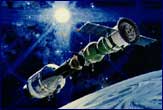 For NASA, the sixties had ended in triumph: Humans had walked on the moon, and NASA
had put them there. For the space agency, the success of the first lunar
landing was an invitation to dream even bigger dreams. NASA administrator Tom
Paine and his deputies planned a stunning array of space activities so
extensive that they would live up to the vision presented in Collier's
magazine in the 1950s. There would be space stations in Earth orbit, a base on
the moon, and human missions to Mars.
For NASA, the sixties had ended in triumph: Humans had walked on the moon, and NASA
had put them there. For the space agency, the success of the first lunar
landing was an invitation to dream even bigger dreams. NASA administrator Tom
Paine and his deputies planned a stunning array of space activities so
extensive that they would live up to the vision presented in Collier's
magazine in the 1950s. There would be space stations in Earth orbit, a base on
the moon, and human missions to Mars.
But these dreams were met by a new, harsh reality: the 1960s
"heyday" for space budgets was over. National priorities had shifted
since John Kennedy had challenged the nation to a lunar landing by decade's
end. The country was preoccupied with an ongoing struggle for civil rights and
dissent over the war in Vietnam. The booming economy of the early 1960s had
given way to concern over inflation. Space exploration no longer headed the
Cold War agenda. And so, when the Nixon administration responded to NASA's
budget requests, Paine's grand vision fell by the wayside.
|
|
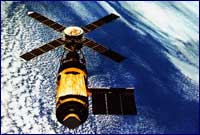
Skylab over earth
|
Only one element of the plan was preserved by the White House and Congress:
A reusable space shuttle that would ferry astronauts to and from Earth orbit.
The shuttle would launch satelllites, and serve as an orbiting research
platform. And NASA promised it would lower the high cost of access to space.
The shuttle would not be ready to fly until 1978 at the earliest. Meanwhile,
a program called Skylab would serve as a follow-on to Apollo. With Skylab, an
Earth-orbit space station constructed largely from spare Apollo hardware,
astronauts would go from visiting space to living there. With as much living
space as a small house, Skylab crews would spend up to three months operating
astronomical telescopes to study the Sun, special cameras to photograph the
Earth in selected wavelengths of light, and other experiments designed to study
the behavior of materials in weightlessness. The astronauts would also study
themselves with a slew of medical experiments.
Apollo's Scientific Finale
Meanwhile, the Apollo moon missions continued to rack up extraordinary
accomplishments. Simply getting to the moon and back had been the goal of the
first Apollo landing crew. But beginning with Apollo 12, the mission began to
emphasize scientific exploration. In November 1969 Apollo 12 astronauts Pete
Conrad and Alan Bean had made history's first pinpoint lunar landing by
touching down within walking distance of the robotic Surveyor 3 probe, which
had rested on the moon's Ocean of Storms since early 1967. In the process, they
had demonstrated that future Apollo crews could set down at some of the most
geologically enticing places on the moon.
|
|
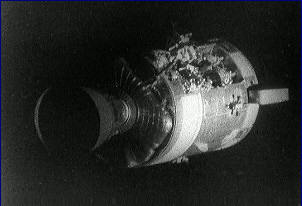
Apollo 13's damaged service module,
seen shortly before reentry.
|
Scientists' hopes were high for the Apollo13 mission which left Earth on
April 11, 1970, bound for the moon's Fra Mauro highlands. But those hopes
evaporated some 55 hours into the mission, when an oxygen tank exploded aboard
the Apollo 13 service module, aborting the flight and plunging NASA into the
worst crisis it had ever faced on a piloted space mission.
Aboard the crippled spacecraft, lunar veteran Jim Lovell and his rookie
crew, Jack Swigert and Fred Haise, were forced to abort their mission and begin
an emergency trip home. To survive, they used their lunar lander as a lifeboat,
utilizing its oxygen, radio, and rocket engines. By the time they reached Earth
four days later, the men were exhausted and battling bone-chilling conditions
aboard their spacecraft. But the combined efforts of the astronauts and
hundreds of flight controllers and engineers on Earth paid off: Lovell's crew
splashed down safely on April 17, crowning a recovery effort that many called
NASA's finest hour.
Picking up the torch from Jim Lovell's crew, Apollo 14 was led by America's
first space traveler, Alan Shepard, who had been grounded since his 1961
Mercury mission by an inner-ear disorder, but restored to health after an
experimental surgery. Shepard's footsteps on the Fra Mauro highlands
represented not only a success for NASA, but a personal triumph.
In the summer of 1971, Apollo's scientific phase got into high gear, as
Apollo 15's Dave Scott and Jim Irwin became the first astronauts to explore the
mountains of the moon. They brought along a new innovation: a battery powered
car called the Lunar Rover that allowed them to range for miles across the
landscape on geologic "treasure hunts."
|
|
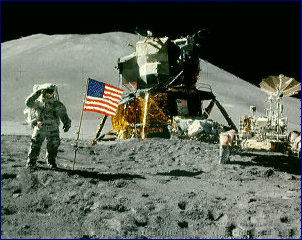
Apollo 15's Jim Irwin poses with the
lunar module and lunar rover (right).
|
For three days, Scott and Irwin lived and worked among the moon's Apennine
mountains. Among their finds was a rock that dated back 4.5 billion years,
almost as old as the moon itself, which became known as the "Genesis
rock." Meanwhile, circling the moon, crewmate Al Worden operated a battery
of scientific cameras and sensors in an intensive orbital reconnaissance.
Even as Apollo 15 demonstrated the new heights Apollo had reached, budget
cuts were bringing the program to a premature end. In 1970 three lunar missions
were canceled, leaving only Apollo 16 and 17 to write the final chapters in the
Apollo saga.
In December 1972, Apollo 17 saw Gene Cernan and geologist-astronaut Jack
Schmitt -- the first professional scientist to visit another world -- explore
the spectacular Taurus Littrow valley, while Ron Evans surveyed the moon from
orbit. When Apollo 17 splashed down in the Pacific, the 20th
century's brief era of human exploration of the moon was over.
Lunar Robots Rock n' Roll
By the early 1970s, the Soviet Union was forced to abandon its efforts to
send people to the moon. Even before Apollo 11's lunar landing, Soviet space
planners had realized they would likely lose the moon race. They had begun
their lunar program relatively late, a few years after the Americans.
|
|
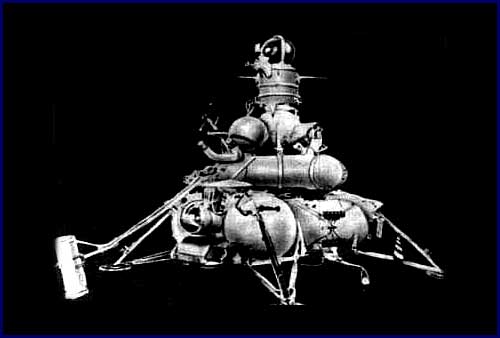
The Soviet Union
launched Luna 16 in
September, 1970. It was the first robotic
probe to land on the moon and return
a sample to Earth.
|
But the most severe blow came from the failure of Sergei Korolev's giant N-1
moon rocket: It exploded during each of its four test-launches between 1969 and
1972. Some still dreamed of catching up with the U.S. program, or even
surpassing it, by establishing a lunar base. But the repeated failures of the
N-1 put an end to such plans. Korolev wasn't around to see his dream abandoned;
he had died during surgery in 1966.
As an alternative, the Soviets staged a series of robotic missions in an
attempt to show the world that they could duplicate Apollo's scientific
harvest, for a fraction of the cost. The first tries at an automated lunar
sample-return came before Apollo 11. But success did not come until September,
1970: Luna 16 touched down on the Sea of Fertility, drilled into the soil, and
launched a return capsule to Earth bearing a small vial of lunar dust and rock
fragments. Luna 20 repeated the feat in 1972, and Luna 24 retrieved a sample
from the Sea of Crisis in 1976.
The Soviets also deployed a pair of automated rovers which roamed the moon
under remote control by engineers on Earth. Named Lunakhod, the rovers were
equipped with television cameras and scientific instruments to investigate the
properties of lunar soil. Lunakhod 1 reached the Sea of Rains in 1970; Lunakhod
2 traveled the Sea of Serenity in 1973.
Soviet Space Marathons
Beginning in the early 1970s, the Soviets' human spaceflight program charted
a new course, into Earth orbit. In 1971, two years before NASA's initial Skylab
mission, they launched the world's first space station, Salyut 1. Three
cosmonauts spent 21 days aboard the station, but their mission ended
tragically: All three men died after a sudden loss of cabin pressure
immediately before their spacecraft made an automatic reentry. Ground teams
rushed to the craft only to find the crew dead inside.
|
|

Cutaway view of the Salyut 4 space station,
with Soyuz ferry attached (left).
|
By September, 1973, the Soviets had recovered from the tragedy and were back
to launching Salyuts for scientific missions. They also inaugurated a series of
Almaz space stations for military reconnaissance, further evidence that the
Cold War was being waged in space as well as on Earth.
The Salyut missions put the Soviet Union at the frontier of long-duration
spaceflight. With a four-month residence on Salyut 6 in 1978, the crew of Soyuz
29 broke the U.S. space endurance record set aboard Skylab. The following year
Soyuz 32 cosmonauts Vladimir Lyakhov and Valeri Ryumin cosmonauts logged an
extraordinary stay of six months the station. Even that record would be
surpassed as the Soviet space marathons continued into the 1980s.
Other Nations in Space
International space activities blossomed in the 1970s. Beginning in 1973,
ten European nations joined forces to form the European Space Agency, or ESA.
ESA's members embarked on a variety of space projects, including development of
a new satellite launcher called Ariane. The first successful Ariane launch in
1979 ushered in a new era of commercial space activities.
Also in 1975, détente found its way into space, if only for a moment, as
the U.S. and Soviet Union staged a joint space mission called the Apollo-Soyuz
Test project. The dual mission, which commanded by Apollo veteran Tom Stafford
and Soviet spacewalker Alexei Leonov, featured the first international space
docking.
The 1970s also saw a growing number of nations launching satellites. China's
first, lofted in 1971, broadcast a melody entitled "East Is Red."
India, whose first satellite was launched by the Soviets in 1975, achieved its
own satellite launch in 1979.
Planetary Exploration's Golden Age
|
|

The Viking 1 lander
reached Mars in 1976.
|
In the 1970s, planetary exploration flourished as U.S. and Soviet robotic
missions sent back a phenomenal haul of data. Mars was the target of the
Mariner 9 spacecraft, which began mapping the planet from orbit in 1971.
Mariner's images revealed towering volcanoes, giant canyons, and winding
valleys that appeared to be dry river beds. In 1976, the twin Viking landers
made the first successful touchdowns on the martian surface, sending back
images and data on the planet's atmosphere and soil. The Vikings' most
celebrated experiment -- a search for signs of microbial life -- failed to find
any conclusive evidence.
|
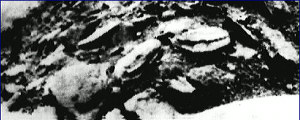
Rocks on the surface of Venus,
photographed by Venera 9 in 1975.
|
|
The Mariner 10 spacecraft was the first to take advantage of a technique
called gravity assist: During a flyby of Venus, the probe used the planet's
gravity to redirect it toward Mercury. Thanks to a lucky coincidence between
Mercury's orbital period and the spacecraft's trajectory, Mariner 10 made not
one but three flybys of the innermost planet.
|
|
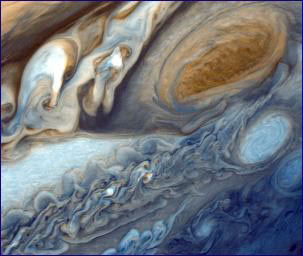
This view of Jupiter
was taken by Voyager 1
|
The Soviets, who had little success in several Mars landing attempts,
succeeded with an even more challenging task: Their Venera landers actually
survived a descent to the hellish surface of Venus. Beneath the planet's dense,
opaque atmosphere, the Venera's found surface pressures 90 times that on Earth,
and temperatures as high as 900 degrees Fahrenheit -- hot enough to melt lead.
The Venera landings gave scientists their first images and in situ data
on the planet's surface composition. But in the 1970s, Venus was the only truly
successful target for Soviet planetary missions.
The United States, meanwhile, turned its attention to the outer solar system
with the Pioneer 10 and 11 spacecraft. These twin probes made the first flybys
of Jupiter and Saturn, sending back valuable glimpses of these planets' cloudy
atmospheres, and valuable data on their powerful magnetic fields. The more
sophisticated Voyager 1 and 2 probes, launched in 1977, began their own
"grand tour" of the outer solar system, a mission that would
ultimately stretch to the end of the 1980s, and even beyond.
Apollo image gallery
NASA-JSC Digital Image Collection
NASA History Office
Russian Space History
Timetable of Space Events: 1970s
|
Piloted
missions
|
| Achievement |
Country |
Crew |
Spacecraft |
Launch
Date |
|
First space
station |
Soviet Union |
Dobrovolski,
Volkov,
Patsayev |
Soyuz 11,
Salyut 1 |
June 6, 1971 |
|
First visit to
lunar mountains; first lunar rover |
United States |
Scott, Worden,
Irwin |
Apollo 15 |
July 26, 1971 |
|
First
one-month mission |
United States |
Conrad, Kerwin,
Weitz |
Skylab 2 |
May 25, 1973 |
|
First
two-month mission |
United States |
Bean, Garriott,
Lousma |
Skylab 3 |
July 28, 1973 |
|
First
three-month mission |
United States |
Carr, Gibson,
Pogue |
Skylab 4 |
November 16,
1973 |
|
First military
space station |
Soviet Union |
(several
crews) |
Salyut 2 |
June 24, 1974 |
|
First
international piloted space mission |
United States,
Soviet Union |
Stafford,
Brand, Slatyton (US);
Leonov, Kubasov (USSR) |
Apollo-Soyuz |
July 15, 1975 |
|
First
four-month mission |
Soviet Union |
Kovalyonok,
Ivanchenkov |
Soyuz 29,
Salyut 6 |
June 5, 1978 |
|
First
six-month mission |
Soviet Union |
Lyakhov,
Ryumin |
Soyuz 32,
Salyut 6 |
February 25,
1979
|
|
Robotic
missions
|
| Achievement |
Country |
Spacecraft |
Launch
Date |
|
First automated lunar sample
return |
Soviet Union |
Luna 16 |
September 12, 1970 |
|
First automated lunar rover |
Soviet Union |
Lunakhod 1 |
November 10, 1970 |
|
First Mars orbiter |
United States |
Mariner 9 |
May 9, 1971 |
|
First Jupiter flyby |
United States |
Pioneer 10 |
March 3, 1972 |
|
First Saturn flyby |
United States |
Pioneer 11 |
April 6, 1973 |
|
First Mercury flyby |
United States |
Mariner 10 |
November 3, 1973 |
|
First Venus landing |
Soviet Union |
Venera 9 |
June 8, 1975 |
|
First Mars landing |
United States |
Viking 1 |
August 30, 1975 |
|
First detailed
reconnaissance
of Jupiter and its moons |
United States |
Voyager 1 |
September 5, 1977
|
http://www.space.com/spacehistory/greatest_70s_991230.html
Copyright ©1999 space.com, inc. ALL RIGHTS RESERVED.
Greatest Space Events of the 20th Century: The 80s
By Andrew Chaikin,
space.com Executive Editor, Space and Science
posted: 06:44 am EST 03 January 2000
|
|
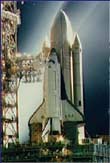
STS-1, the first
shuttle launch
|
On April 12, 1981, twenty years to the day after Yuri Gagarin became the
world's first space traveler, a new type of space vehicle stood ready for
launch at the Kennedy Space Center. To the eye it appeared as an unlikely
collection of forms: Something resembling an airplane, standing on its tail,
was attached to a huge cylinder the size of a grain silo, which in turn was
accompanied by a pair of slender rockets.
This was the Space Shuttle Columbia, first of a planned fleet of
reusable spaceships. The winged shuttle orbiter, the size of a commercial
jetliner, was designed for a hundred trips into space. Drawing its fuel from a
giant external tank, the orbiter's three engines would deliver 4.3 million
pounds of thrust at liftoff, with an additional 2.6 million pounds of thrust
being supplied by twin solid rocket boosters.
With a 60-foot-long cargo bay, the shuttle was capable of carrying new
satellites into space, or retrieving an ailing spacecraft for repair. NASA
hoped the shuttle would usher in a new era of spaceflight. So did the new corps
of astronauts selected to fly it; for the first time in the U.S. space program
they included women and minorities.
Columbia's commander was John Young, veteran of Gemini and Apollo, and
one of the world's most experienced space travelers. Together with his
co-pilot, a rookie named Bob Crippen, Young had prepared for more than two
years to fly the shuttle's maiden voyage, officially designated STS-1
("STS" stands for Space Transportation System).
Everyone knew the risks Young and Crippen were taking: The shuttle was the
most complex space vehicle ever devised, and there were countless possibilities
for things to go wrong, bringing failure or even disaster.
The Shuttle Era Begins
|
|

Astronaut Bruce McCandless,
mission
specialist, a few meters away from the
cabin of the shuttle Challenger.
|
When the moment of launch came, however, everything worked perfectly.
Seconds before liftoff Columbia's three main engines ignited, followed
by the two solid rocket boosters, and the shuttle roared toward orbit. In
space, the astronauts discovered that the orbiter had lost some of its
heat-protective silica tiles, raising concerns for the craft's fiery reentry
into the Earth's atmosphere.
But Columbia performed, in Young's words, "like a champ,"
and the mission ended on April 14 with a picture-perfect landing on a desert
runway at California's Edwards Air Force Base. Addressing a crowd of
well-wishers Young declared, "We're really not too far, the human race
isn't, from going to the stars."
Later in 1981,Columbia proved its reusability by flying a second
mission, and in 1982 it flew three more. The orbiter's fifth flight, STS-5, was
also the first operational mission of the shuttle program, and inaugurated the
shuttle as a satellite launcher, leaving two commercial communications
satellites in Earth orbit.
STS-5 also featured the first so-called mission specialists, astronauts
whose job was not to fly the orbiter but to carry out experiments and other
tasks in orbit. Up to six mission specialists -- for a total crew of eight
people -- could fly on the shuttle at once.
In February 1984, spacewalking shuttle astronauts tested a Buck Rogers-style
jet-pack called the Manned Maneuvering Unit. In April of that year,
spacewalkers Pinky Nelson and Ox van Hoften became the first on-site satellite
repairers when they fixed the ailing Solar Maximum Mission astronomical
satellite.
Disaster Strikes
|
|

STS-51L Mission Control:
"Obviously . . . a major malfunction."
|
By late 1985, NASA was operating a fleet of four shuttle orbiters and
setting a record pace of launches. That year nine shuttle missions were flown,
and even more flights were planned in 1986. There was even a program in the
works to fly ordinary citizens in space.
There was reason for the break-neck pace. The shuttle had not lowered the
costs of access to Earth orbit. And for commercial launches, NASA was facing
stiff competition from Europe's Ariane rocket, which enjoyed government
subsidies and lower operating costs. NASA's original forecasts had called for a
shuttle flight almost every week, and while no one at the agency believed that
goal was attainable, some still talked of flying 24 missions per year. But that
was not to be.
On January 28, 1986, the shuttle Challenger exploded 73 seconds after
liftoff, killing its seven-member crew, including schoolteacher Christa
McAuliffe. The disaster stunned the nation and shattered any illusions that
spaceflight had become routine. For NASA, it brought the realization that the
agency had been living too close to the edge.
Months of investigation by a presidential commission traced the Challenger
accident to a bad seal in a solid rocket booster. And there was also
criticism of the decision-making process that had cleared the shuttle for
launch in unusually cold conditions. As NASA struggled to recover from the
disaster, the United States scrambled to shift its satellite-launching tasks to
expendable rockets. Many payloads slated for shuttle launches, including the
Hubble Space Telescope, would face years of delay.
|
|
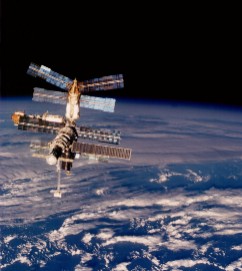
Mir
|
Space Station Mir
For the Soviet Union, 1986 was the beginning of a new era in long-duration
space missions, with the launching of the first modular space station, called
Mir ("Peace"). Mir, whose crews would make even longer stays, offered
somewhat more room and more "creature comforts" than Salyut. It was
also the first space station meant for continuous occupation.
Already, cosmonauts had set a new space endurance record of 237 days --
almost 8 months -- aboard the Salyut 7 space station. In December 1987,
Vladimir Titov and Musa Maranov arrived at Mir; they returned to Earth a year
later.
Around this time, the Soviets were talking openly of plans to send humans to
Mars. Before that could happen, however, long-duration missions in Earth orbit
would have to find ways of keeping space travelers healthy -- physically and
psychologically -- during months or even years in space.
To break the monotony of their space marathons, Salyut and Mir crews were
visited occasionally by teams of cosmonauts, including a number of "guest
cosmonauts" selected from various Soviet-bloc nations. They also received
shipments of mail, supplies, and gifts via unpiloted Progress spacecraft.
|
|
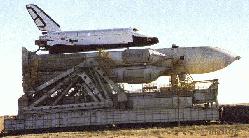
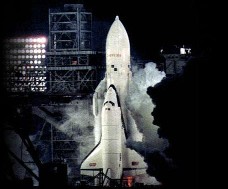
Buran transporter and launch
|
On Earth, meanwhile, Soviet space planners, who had feared the U.S. Space
Shuttle might be used to drop nuclear weapons, were ready to inaugurate a
shuttle of their own. Called Buran ("snowstorm"), it closely
resembled the American shuttle orbiter, but had the ability to fly under remote
control from Earth, and to make powered landings.
Buran was mated to a giant new booster called Energia for launch. But
the high costs of military and civilian space programs were catching up with
the Soviets, and Buran made only a single, unpiloted mission, in
November 1988. The following year marked the dissolution of the Soviet Union,
and the end of the Cold War that had spawned so many space accomplishments.
A Time of Limits
Funding was also an issue for the U.S. space program, especially in the area
of space science. With most of NASA's budget going to support the Space Shuttle
program, relatively little was left for robotic missions.
Although the twin Voyager probes continued to provide stunning data -- after
surveying Jupiter they flew past Saturn, and Voyager 2 continued to Uranus and
Neptune -- few successors were in the works. When Halley's Comet made a rare
appearance in the inner solar system in 1985-86, the U.S. was not among the
nations who launched space probes for close encounters with the comet.
|
|

NASA stores recovered
wreckage from the
Challenger explosion in underground silos
at Cape Canaveral previously used to house
Minutemen missiles.
|
And in the aftermath of the Challenger accident, delays and
cancellations meant that only two new planetary missions were launched during
the 1980s: the radar-equipped Magellan Venus orbiter and the Galileo Jupiter
orbiter, each dispatched by shuttle astronauts in 1989.
At the same time, NASA was working toward another of its cherished goals, a
permanent space station in Earth orbit. By the time the Space Shuttle was
flying again in September 1988, the agency had gained approval for the project.
The station became an international venture as NASA joined forces with the
European Space Agency, Canada, and Japan. At the close of the decade, however,
the station was mired in bureaucracy, its design and completion date uncertain.
The space station would continue to draw much of NASA's energies in the
1990s, as the agency struggled to redefine itself and its goals in space.
NASA Human Spaceflight
Mir space station -- Maximov online
Russianspace.com
Presidential Commission Report on Challenger Accident
Timetable of Space Events: 1980s
|
Piloted
missions |
|
Achievement |
Country |
Crew |
Spacecraft |
Launch Date |
|
First reusable spacecraft |
United States |
Young, Crippen |
Columbia |
April 12, 1981 |
|
First untethered spacewalk |
United States |
Brand, Gibson, McCandless,
McNair, Stewart |
Challenger |
February 3, 1984 |
|
First in-space satellite
repair |
United States |
Crippen, Scobee, Hart,
Nelson, van Hoften |
Challenger |
April 6, 1984 |
|
First modular space station |
Soviet Union |
(several crews) |
Mir |
February 19, 1986 |
|
First year-long spaceflight |
Soviet Union |
Titov, Maranov |
Mir space station |
December 21, 1987 |
|
Robotic
missions |
|
Achievement |
Country |
Spacecraft |
Launch Date |
|
First detailed
reconnaissnace of Saturn and its moons |
United States |
Voyager 1 |
September 5, 1977 |
|
First Uranus flyby |
United States |
Voyager 2 |
August 20, 1977 |
|
First images of cometary
nucleus (Halley) |
Soviet Union |
Vega 1 |
December 15, 1984 |
|
First Neptune flyby |
United States |
Voyager 2 |
August 20, 1977 |
http://www.space.com/spacehistory/yir_greatest1980s_000103.html
Copyright ©1999 space.com, inc. ALL RIGHTS RESERVED.
Greatest Space Events of the 20th Century: The Nineties
By Andrew Chaikin and
Anatoly Zak, space.com
posted: 01:55 pm EST 05 January 2000
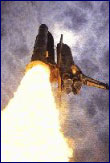 The 1990s began with a profound change in the world's political structure. In 1991
the Soviet Union was dissolved. The event marked the end of the Cold War that
had spawned so many space accomplishments.
The 1990s began with a profound change in the world's political structure. In 1991
the Soviet Union was dissolved. The event marked the end of the Cold War that
had spawned so many space accomplishments.
In Russia, which inherited most of the Soviet space industry, economic
hardship loomed. Russian officials found themselves having to negotiate with
Kazakhstan for access to Baikonour, their space program's main launch complex.
And the Energia-Buran program, the Russian equivalent of the U.S. space
shuttle, was officially scrapped in 1993.
Mir: crises and kudos
The upheavals, however, did not prevent Russia from making the 1990s an
extraordinary decade in human spaceflight.
The Mir space station, launched in 1986, continued to host crews for
ever-longer missions. In March 1995 physician-cosmonaut Valeri Polyakov
concluded an astonishing 14 months aboard the station, setting a world space
endurance record that still stands.
|
|
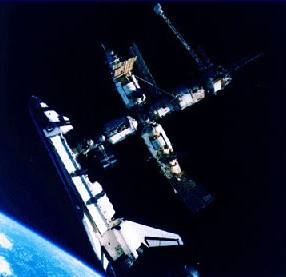
The Space Shuttle Atlantis docked
to the Mir space station in 1995
|
That year also saw the first visits of American astronauts to Mir, something
that would have been unthinkable a decade earlier.
The Shuttle-Mir missions were designed to pave the way for future joint
space operations by the two nations. In the meantime, they gave U.S. astronauts
their first experience with long space missions since the Skylab marathons of
the early 1970s. Astronaut Shannon Lucid set a U.S. space endurance record of
six months with her Mir visit in 1996.
To NASA's surprise, some of the biggest problems that surfaced during the
Shuttle-Mir flights were cultural, not technological. The effort to merge the
space programs of two very different societies was fraught with personality
conflicts -- both in space and on the ground. There were times when NASA
engineers and astronauts working at the Moscow control center must have felt
like aliens on a hostile planet.
But their difficulties paled before the crises that assailed the Shuttle-Mir
crews. In February 1997, a serious fire blazed in one of the station's modules
when an oxygen generator malfunctioned, nearly forcing U.S. astronaut Jerry
Linenger and his Russian crewmates to evacuate. The fire wasn’t the end of
their difficulties; the station's plumbing leaked toxic coolant, and the two
Mir cosmonauts were besieged by a relentless workload.
Linenger's replacement, astronaut Mike Foale, had his own crisis when an
automated Progress supply spacecraft struck the station. The collision
punctured one of the station's six modules, causing an air leak that was
stopped by the quick action of the crew who sealed off the damaged compartment.
The crash also damaged one of Mir's solar panels, shutting off much of its
electrical power system. The station drifted, starved for power, until Foale
and the cosmonauts could bring the station back to life.
The collision was the worst in a seemingly endless series of equipment
failures and other problems. In the American public and media, there was
criticism and even ridicule of the Russian space station. But some experienced
observers had a different view: the station had lasted far longer than any of
its designers had a right to expect. The Mir crews had demonstrated
extraordinary courage and persistence in keeping the station alive.
By the time Mir was abandoned in the summer of 1999 -- after more than 13
years of operations -- the Russians had shown that humans could face daunting,
even terrifying problems in space, and succeed.
NASA's rocky road
|
|
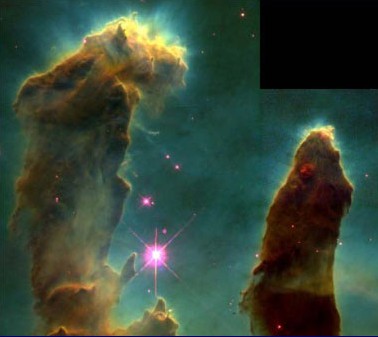
Pillars of gas and dust tower within the Eagle nebula
in this 1995 image from the Hubble Space Telescope.
|
For NASA, the 1990s got off to a shaky start. In 1990, the long-delayed
Hubble Space Telescope was deployed from Space Shuttle Discovery. But soon
after the $1.5-billion telescope reached orbit, astronomers realized its main
mirror was flawed. Already, its stunning images were delighting astronomers.
But without a difficult repair by shuttle astronauts, the telescope would never
realize its full potential.
NASA's can-do image was bolstered once more in 1993, when spacewalking
shuttle astronauts staged one of the most demanding space repair jobs ever, to
fix the Hubble Space Telescope. After receiving a set of corrective lenses, the
telescope performed even better than originally planned. The repair came just
in time for Hubble to record the crash of Comet Shoemaker-Levy into Jupiter in
July 1994.
Then, in 1992, came a mishap that transformed NASA's planetary exploration
program. That summer, scientists eagerly awaited the arrival at Mars of the
Mars Observer spacecraft, which was slated to carry out a detailed study of the
planet's surface and atmosphere from orbit. But ground stations lost contact
with the probe shortly before it was due to go into martian orbit. Analysts
concluded that the $1-billion craft was lost, probably because of a massive
fuel leak.
For NASA administrator Dan Goldin, the loss of Mars Observer hit hard. It
was clear to Goldin that the agency's long-standing penchant for big, expensive
space missions, with decade-plus lead times, had to change. When it came to
planetary exploration, NASA couldn't afford to put its eggs in a
one-billion-dollar basket. Goldin gave the agency a new motto: Faster, better,
cheaper.
|
|
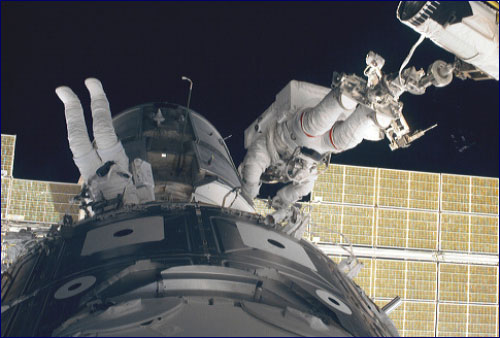
Spacewalking astronauts assemble the first two modules
of the International Space Station in 1998.
|
In 1993, NASA's space station program was revamped. Already plagued by
endless delays, revisions and cost overruns, the International Space Station --
for both economic and political reasons -- would now include Russia (and
Russian space hardware from a planned Mir 2 program) as a key partner.
On the planetary exploration front, Mars was the first target for the less
expensive missions, with the Mars Surveyor program. For each new martian launch
opportunity, 26 months apart, NASA would launch a new pair of Mars spacecraft.
Another program, called Mars Pathfinder, would develop a network of small
spacecraft to land on the Red Planet. And the New Millennium program would test
new technologies for a variety of deep-space missions.
But it was a tiny spacecraft called Clementine -- a creation not by NASA,
but derived from the ill-fated "Star Wars" ballistic missile defense
program -- that first demonstrated the potential of the "faster, better,
cheaper" approach.
Clementine's arrival in lunar orbit in 1994 was the first U.S. mission to
the moon since the end of the Apollo program. While its scientific
accomplishments didn't rival Apollo's, Clementine did send back high-resolution
images and valuable data on the surface composition. And it discovered the
first signs of water on our natural satellite, in the form of ice grains
probably deposited over billions of years by comet impacts.
Mars beckons
|
|
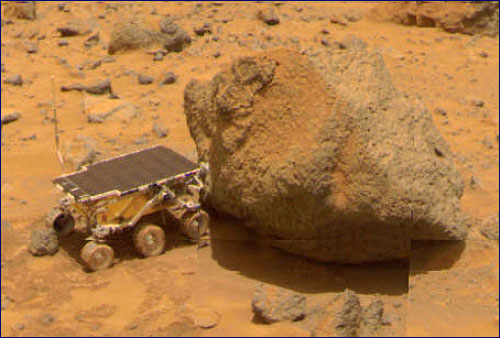
The Sojourner rover examines a Martian boulder nicknamed Yogi in 1997
|
For Russia, Mars had long been an unrealized goal. Adding to a long string
of unsuccessful missions to the Red Planet, a pair of orbiters called Phobos 1
and 2 were lost before completing their missions in 1988.
After the dissolution of the Soviet Union, Russian space scientists faced a
new set of obstacles, namely the country's disintegrating space industry and
dwindling government funds. They worked for months without pay to prepare a new
pair of Mars spacecraft -- an orbiter and several landers outfitted with a
suite of scientific instruments -- for a November 1996 launch. The blaze of a
Proton rocket heralded the Mars '96 probe's departure. But a malfunctioning
upper stage failed to send the craft out of Earth orbit, ending the Russian's
last attempt at planetary exploration in the 1990s.
NASA scored a success in its Mars exploration program when the Pathfinder
spacecraft arrived on the Martian surface in July 1997, some 21 years after the
twin Viking probes touched down. Unlike the Vikings, however, Pathfinder used
airbags to cushion its impact. Shortly after landing, the craft deployed a
diminutive rover called Sojourner, which roamed the landing site under remote
control from Earth, examining rocks and patches of soil.
The success of Pathfinder and Sojourner, which were produced for a fraction
of Viking's cost, seemed to vindicate NASA's faster, better, cheaper credo. But
the failure of four Mars spacecraft in 1999 -- Mars Climate Orbiter, Mars Polar
Lander and a pair of Mars Microprobes -- forced the agency to reexamine the
risks of its new approach.
|
|
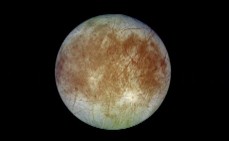

Trailing hemisphere of Europa, and
color-
enhanced close-up showing bluish water
ice and brownish double ridges.
|
Still, everyone at NASA understood that there was no turning back: the era
of high-cost planetary missions was long over. And in the aftermath of the
Polar Lander's failure in December, 1999, NASA planners focused on how to
improve chances for success in future Mars missions, including a sample-return
slated for launch in 2005.
Life beyond Earth?
The goal of returning a piece of Mars to Earth became even more alluring in
1996, when NASA scientists announced they had found evidence of fossil bacteria
inside a meteorite from Mars. While their claims remain controversial, they
moved the subject of extraterrestrial life from the fringe to the mainstream of
space science. It was clear that future Mars exploration could gather clues to
whether life exists, or ever existed, on the Red Planet.
Still farther from home, Jupiter's moon Europa yielded clues that it might
be an abode for life. High-resolution images from the orbiting Galileo
spacecraft supported theories that beneath Europa's icy crust might exist an
ocean of liquid water. It wasn't long before scientists began thinking about
21st-century robotic missions to drill through the ice and search for signs of
living organisms.
A new century in space
|
|

The unmanned Shenzhou capsule landed after 21
hours (14 orbits) in space. It is believed to
accommodate up to four "taikonauts".
|
As the 1990s ended China launched a prototype of a piloted spacecraft, with
plans to send people into Earth orbit in the first years of the new century.
The United States and Russia collaborated on a mobile, ocean-based satellite
launcher called Sea Launch. Also, NASA's Cassini orbiter, the last of the
high-cost planetary probes, was en route to Saturn.
A probe called Stardust was heading for a rendezvous with a comet, with the
goal of collecting samples of its dust for return to Earth. Crews of shuttle
astronauts deployed an orbiting X-ray telescope called Chandra, and restored
the ailing Hubble telescope to its work helping to reveal the mysteries of the
universe. The first two modules of the International Space Station circled 200
miles above the Earth, awaiting further construction. And 77-year-old John
Glenn, America's first man in orbit, became the world's oldest space traveler
when he logged a nine-day shuttle flight.
These were just a part of the universe of space activities at the end of the
20th century. And a host of space projects, in production or on the drawing
board, offered evidence that in the 21st century, human beings and their
robotic surrogates would continue to explore the final frontier.
Timetable of space events: 1990s
|
Piloted
missions |
|
Achievement |
Country |
Crew |
Spacecraft |
Launch Date |
|
World spaceflight endurance
record |
Russia |
Polyakov |
Mir |
January 8, 1994 |
|
U.S. spaceflight endurance
record |
United States |
Lucid |
Atlantis / Mir |
March 22, 1996 |
|
First docking of Space
Shuttle and Mir space station |
United States |
Gibson, Precourt, Baker,
Harbaugh, Dunbar, Solovyev, Budarin |
Discovery |
June 27, 1995 |
|
First International Space
Station visit |
United States / Russia |
Cabana, Sturckow, Currie,
Newman, Ross, Krikalev |
Endeavour |
December 4, 1998 |
|
Robotic
missions |
|
Achievement |
Country |
Spacecraft |
Launch Date |
|
First large space telescope |
United States |
Hubble Space Telescope |
April 24, 1990 |
|
First asteroid flyby |
United States |
Galileo |
October 18, 1989 |
|
First Jupiter orbiter |
United States |
Galileo orbiter |
October 18, 1989 |
|
First probe into Jupiter
atmosphere |
United States |
Galileo probe |
October 18, 1989 |
|
First planetary rover |
United States |
Pathfinder/ Sojourner |
December 4, 1996 |
|
First mobile, ocean-based
satellite launcher |
United States / Russia |
Zenit / Sea Launch |
March 28, 1999 |
http://www.space.com/spacehistory/greatest_1990s_000105.html
Copyright ©2000 space.com, inc. ALL RIGHTS RESERVED.



 When you think of the 1950s, you might recall the decade's contributions to popular
culture: Rock n' Roll, hula hoops, and horror films featuring a menagerie of giant
radioactive beasts. Long after Godzilla is forgotten, however, the fifties will be
remembered as the dawn of the space age.
When you think of the 1950s, you might recall the decade's contributions to popular
culture: Rock n' Roll, hula hoops, and horror films featuring a menagerie of giant
radioactive beasts. Long after Godzilla is forgotten, however, the fifties will be
remembered as the dawn of the space age.

















 For NASA, the sixties had ended in triumph: Humans had walked on the moon, and NASA
had put them there. For the space agency, the success of the first lunar
landing was an invitation to dream even bigger dreams. NASA administrator Tom
Paine and his deputies planned a stunning array of space activities so
extensive that they would live up to the vision presented in Collier's
magazine in the 1950s. There would be space stations in Earth orbit, a base on
the moon, and human missions to Mars.
For NASA, the sixties had ended in triumph: Humans had walked on the moon, and NASA
had put them there. For the space agency, the success of the first lunar
landing was an invitation to dream even bigger dreams. NASA administrator Tom
Paine and his deputies planned a stunning array of space activities so
extensive that they would live up to the vision presented in Collier's
magazine in the 1950s. There would be space stations in Earth orbit, a base on
the moon, and human missions to Mars.














 The 1990s began with a profound change in the world's political structure. In 1991
the Soviet Union was dissolved. The event marked the end of the Cold War that
had spawned so many space accomplishments.
The 1990s began with a profound change in the world's political structure. In 1991
the Soviet Union was dissolved. The event marked the end of the Cold War that
had spawned so many space accomplishments.





